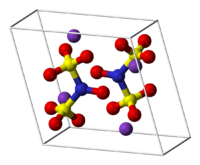弗氏鹽
外觀
| 弗氏鹽 | |
|---|---|

| |

| |
| IUPAC名 Potassium nitrosodisulfonate | |
| 別名 | 亞硝基二磺酸鉀 |
| 識別 | |
| CAS號 | 14293-70-0 |
| PubChem | 3032624 |
| ChemSpider | 2297553 |
| SMILES |
|
| 性質 | |
| 化學式 | K2NO(SO3)2 |
| 摩爾質量 | 268.33 (鉀鹽) g·mol⁻¹ |
| 危險性 | |
| 警示術語 | R:R14 R20/21/22 |
| 安全術語 | S:S36 |
| H-術語 | H260, H302, H312, H332 |
| P-術語 | P223, P231+232, P280, P301+312, P302+352+312, P304+340+312 |
| 主要危害 | 有害 (Xn) |
| 若非註明,所有數據均出自標準狀態(25 ℃,100 kPa)下。 | |
弗氏鹽是一種無機化合物,化學式 (K4[ON(SO3)2]2),有時寫作 (K2[NO(SO3)2])。它是一種亮黃棕色固體,但水溶液是亮紫色的。[1][2] 相關的鈉鹽亞硝基二磺酸鈉(簡稱NDS,化學式 Na2ON(SO3)2,CAS號 29554-37-8)也被稱為弗氏鹽。[3]
應用
[編輯]弗氏鹽作為一種長壽命的自由基,是電子自旋共振 (EPR) 的標準。其強烈的EPR譜線由三條等強度的線主導,間距約為 13 G(1.3 mT)。[4][5][6]
弗氏鹽可用於某些氧化反應,例如某些苯胺或苯酚的氧化。[7][8][9][10][11]它也允許肽和基於肽的水凝膠的聚合和交聯。[12][13]
它還可以用作研究中過氧自由基的模型,以研究各種天然產品中抗氧化作用的機制。[14]
製備
[編輯]弗氏鹽可以由羥胺二磺酸開始製備而成。氧化它的共軛鹼可以得到紫色的雙陰離子:
- HON(SO3H)2 → [HON(SO3)2]2− + 2 H+
- 2 [HON(SO3)2]2− + PbO2 → 2 [ON(SO3)2]2− + PbO + H2O
羥胺二磺酸鹽則是由亞硝酸鹽和亞硫酸氫鹽反應而成的。氧化反應通常是在低溫下進行的,可以通過化學方法或電解達成。[3][2]
其它製備方法:
- HNO2 + 2 HSO−
3 → HON(SO
3)2−
2 + H2O - 3 HON(SO
3)2−
2 + MnO−
4 + H+ → 3 ON(SO
3)2−
2 + MnO2 + 2 H2O - 2 ON(SO
3)2−
2 + 4 K+ → K4[ON(SO3)2]2
歷史
[編輯]弗氏鹽是在1845年由埃德蒙·弗雷米 (1814–1894)發現的。[15]
參考資料
[編輯]- ^ Greenwood, Norman Neill; Earnshaw, Alan. Chemistry of the elements. 2016. ISBN 978-0-7506-3365-9. OCLC 1040112384 (英語).
- ^ 2.0 2.1 Synthesis and Characterization of Potassium Nitrosodisulfonate, Frémy's Salt (PDF). tripod.com. [2021-12-03]. (原始內容 (PDF)存檔於2010-09-23).
- ^ 3.0 3.1 Wehrli PA, Pigott F. Oxidation with the nitrosodisulfonate radical. I. Preparation and use of sodium nitrosodisulfonate: trimethyl-p-benzoquinone. Organic Syntheses. 1972, 52: 83. doi:10.15227/orgsyn.052.0083.
- ^ Wertz JE, Bolton JR. Electron Spin Resonance: Elementary Theory and Practical Applications. New York: McGraw-Hill. 1972. ISBN 978-0-07-069454-5. See page 463 for information on intensity measurements and page 86 for an EPR spectrum of Frémy's salt.
- ^ Colacicchi S, Carnicelli V, Gualtieri G, Di Giulio A. EPR study of Frémy's salt nitroxide reduction by ascorbic acid; influence of bulk pH values. Res. Chem. Intermed. 2000, 26 (9): 885–896. S2CID 98775951. doi:10.1163/156856700X00372.
- ^ Zielonka J, Zhao H, Xu Y, Kalyanaraman B. Mechanistic similarities between oxidation of hydroethidine by Frémy's salt and superoxide: stopped-flow optical and EPR studies. Free Radical Biology & Medicine. October 2005, 39 (7): 853–863. PMID 16140206. doi:10.1016/j.freeradbiomed.2005.05.001.
- ^ Zimmer H, Lankin DC, Horgan SW. Oxidations with potassium nitrosodisulfonate (Frémy's radical). Teuber reaction.. Chemical Reviews. 1971, 71 (2): 229–246. doi:10.1021/cr60270a005.
- ^ Islam I, Skibo EB, Dorr RT, Alberts DS. Structure-activity studies of antitumor agents based on pyrrolo[1,2-a]benzimidazoles: new reductive alkylating DNA cleaving agents. Journal of Medicinal Chemistry. October 1991, 34 (10): 2954–2961. PMID 1920349. doi:10.1021/jm00114a003.
- ^ Teuber HJ, Benz S. Reaktionen mit Nitrosodisulfonat, XXXVI. Chinolin-chinone-(5.6) aus 5-Hydroxy-chinolinen. Chem. Ber. 1967, 100 (9): 2918–2929. doi:10.1002/cber.19671000916 (德語).[失效連結]
- ^ Teuber HJ. Use of dipotassium nitrosodisulfonate (Frémy's salt): 4,5-dimethyl-o-benzoquinone. Org. Synth. 1972, 52: 88. doi:10.15227/orgsyn.052.0088.
- ^ Xue W, Warshawsky D, Rance M, Jayasimhulu K. A metabolic activation mechanism of 7H-dibenzo[c,g]carbozole via o-quinone. Part 1: synthesis of 7H-dibenzo[c,g]carbozole-3,4-dione and reactions with nucleophiles. Polycyclic Aromatic Compounds. 2002, 22 (3–4): 295–300. S2CID 95507636. doi:10.1080/10406630290026957.
- ^ Wilchek M, Miron T. Mussel-inspired new approach for polymerization and cross-linking of peptides and proteins containing tyrosines by Frémy's salt oxidation. Bioconjugate Chemistry. March 2015, 26 (3): 502–510. PMID 25692389. doi:10.1021/bc5006152.
- ^ Fichman G, Schneider JP. Utilizing Frémy's Salt to Increase the Mechanical Rigidity of Supramolecular Peptide-Based Gel Networks. Frontiers in Bioengineering and Biotechnology. 2021, 8: 594258. PMC 7813677
 . PMID 33469530. doi:10.3389/fbioe.2020.594258
. PMID 33469530. doi:10.3389/fbioe.2020.594258  (英語).
(英語).
- ^ Liu ZL, Han ZX, Chen P, Liu YC. Stopped-flow ESR study on the reactivity of vitamin E, vitamin C and its lipophilic derivatives towards Frémy's salt in micellar systems. Chemistry and Physics of Lipids. November 1990, 56 (1): 73–80. PMID 1965427. doi:10.1016/0009-3084(90)90090-E.
- ^ 參見:
- Frémy, E. (1845) "Sur un nouvelle série d'acides formés d'oxygène, de soufre, d'hydrogène et de d'azote" (頁面存檔備份,存於互聯網檔案館) (On a new series of acids formed from oxygen, sulfur, hydrogen, and nitrogen), Annales de Chimie et de Physique, 3rd series, 15 : 408-488. Frémy's salt appears on p. 447 (頁面存檔備份,存於互聯網檔案館), where it's called "sulfazidate de potasse".
- Frémy, E. (1845) "Sur un nouvelle série d'acides formés d'oxygène, de soufre, d'hydrogène et de d'azote" (頁面存檔備份,存於互聯網檔案館) (On a new series of acids formed from oxygen, sulfur, hydrogen, and nitrogen), Comptes rendus, 21 : 218–226. This is a condensed version of the article that appeared in Annales de Chimie et de Physique.
- "Séances académiques," L'Institut, no. 604, 23 July 1845, pp. 265–266. (頁面存檔備份,存於互聯網檔案館)
- "Séances académiques," L'Institut, no. 619, 12 November 1845, pp. 393. (頁面存檔備份,存於互聯網檔案館) Here a committee of the French Academy of Sciences reviewed Frémy's findings.
- Edward Divers and Tamemasa Haga (1900) "Identification and constitution of Frémy's sulphazotised salts of potassium," (頁面存檔備份,存於互聯網檔案館) Journal of the Chemical Society, Transactions, 77 : 440-446. doi:10.1039/CT9007700440 Here, correct formulae for Frémy's salts are presented. On p. 445 (頁面存檔備份,存於互聯網檔案館), the salt that Frémy called sulfazidate is identified as ON(SO3K)2.
擴展閱讀
[編輯]- Morey J. Undergraduate Experiments with a Long-Lived Radical (Frémy's salt): Synthesis of 1,4-Benzoquinones by Degradative Oxidation of p-Hydroxybenzyl Alcohols. J. Chem. Educ. 1988, 65 (7): 627–629. Bibcode:1988JChEd..65..627M. doi:10.1021/ed065p627.
